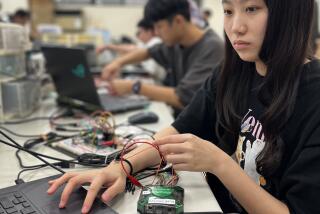For Want of a Tiny Chip . . . : U.S. Needs to Rev Up Its Semiconductor Engine
- Share via
American economic stability well into the next century may teeter on a tiny chip, barely the size of a child’s fingernail. The key ingredient in modern electronics, semiconductors drive $820-billion worth of business worldwide each year. The industry employs 2.6 million Americans--more than the auto, aerospace and steel industries combined.
Yet the United States is steadily losing its share of this growing sector of the global economy--in part because Japan and West Germany support consumer-oriented science and have made high technology a national priority. A recent report by the National Advisory Committee on Semiconductors addresses the slide in U.S. market share and recommends ways in which government can stimulate more high-tech research and development. The report’s most noteworthy recommendations include:
Investment Incentives: With new high-tech facilities costing up to $200 million, investment should be promoted with tax reforms. Each time the computer chip grows more sophisticated it gains more consumer applications--but it also becomes more expensive for business to produce in order to capitalize on new breakthroughs. A 50% investment credit eliminated by 1986 tax reforms should be restored.
New Funding for Research: Either through new tax credits or government grants, money must be found for research. Science can be painfully slow and commercial creditors are reluctant to fund ventures that offer so few guarantees.
Science Education: American business in general is finding skilled labor--indeed, literate workers--increasingly scarce. The study of crucial fields, including science and technology, must be made more attractive by increasing financial aid.
Promotion of Joint Ventures: Reformed anti-trust laws are critical to the future of the semiconductor industry. Companies should be encouraged to pool their research and development resources. For businesses bogged down in red ink, it is often easier to court a foreign buyer than to regain a competitive edge.
One worthwhile venture is Sematech, a research consortium funded by $100 million per year in government grants as well as matching industry contributions. Among other activities, Sematech finances research and development at U.S. universities. The National Advisory Committee recommends increasing the organization’s budget, but cash freed up by tax incentives could finance the same ventures.
Staving off the collapse of U.S. high-technology manufacturing requires, in effect, a de facto industrial policy. But if structural and policy changes allow the industry to heal itself, the tax base created by revitalized semiconductor trade would provide the best possible answer to any ideological objections to putting national resources behind a growing and lucrative industry.






